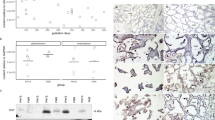Summary
Oxytocin was measured in maternal and fetal plasma, amniotic fluid and neonatal plasma and urine using a specific radioimmunoassay, following extraction procedures with Florisil. Maternal oxytocin levels rose progressively with advancing gestation, but there were no significant differences between oxytocin levels around the onset of labor. No diurnal rhythm of oxytocin was evident in maternal plasma during the third trimester. Maternal and umbilical plasma oxytocin levels at spontaneous delivery were significantly higher than those at elective cesarean section. Maternal oxytocin levels in four cases of post-term delivery were lower than those during normal late pregnancy; all four cases exprerienced uterine inertia. All amniotic fluid samples had detectable oxytocin levels and there were no significant differences between oxytocin levels in the second trimester and those in the third trimester. Oxytocin levels in neonatal urine were higher than levels in amniotic fluid and lower than in the umbilical artery. Neonatal plasma oxytocin levels gradually decreased and oxytocin levels of 7-day-old infants were significantly lower than those in the umbilical artery, but higher than those in adults. In conclusion, it appears that maternal oxytocin levels may not be involved in triggering the onset of labor but may play a role in the maintenance and reinforcement of labor.
Similar content being viewed by others
References
Artman HG, Leake RD, Weitzman RE, Sawyer WH, Fisher DA (1984) Radioimmunoassay of vasotocin, vasopressin, and oxytocin in human neonatal cerebrospinal and amniotic fluid. Dev Pharmacol Ther 7:39–49
Burford GD, Robinson ICAF (1982) Oxytocin, vasopressin and neurophysins in the hypothalamo-neurohypophysial system of the human fetus. J Endocrinol 95:403–408
Chard T, Boyd NRH, Forsling ML, McNeilly AS, Landon J (1970) The development of a radioimmunoassay for oxytocin: the extraction of oxytocin from plasma, and its measurement during parturition in human and goat blood. J Endocrinol 48:223–234
Dawood MY, Raghavan KS, Pociask C, Fuchs F (1978) Oxytocin in human pregnancy and parturition. Obstet Gynecol 51:138–143
Dawood MY, Raghavan KS, Pociask C (1978) Radioimmunoassay of oxytocin. J Endocrinol 76:261–270
Dawood MY, Wang CF, Gupta R, Fuchs F (1978) Fetal contribution to oxytocin in human labor. Obstet Gynecol 52:205–209
Dawood MY, Ylikorkala O, Trivedi D, Fuchs F (1979) Oxytocin in maternal circulation and amniotic fluid during pregnancy. J Clin Endocrinol Metab 49:429–434
Dicker SE, Tyler C (1953) Vasopressor and oxytocic activities of the pituitary glands of rats, guineapigs and cats and of human foetuses. J Physiol 121:206–214
Fuchs AR, Husslein P, Fuchs F (1981) Oxytocin and the initiation of human parturition. II. Stimulation of prostaglandin production in human decidua by oxytocin. Am J Obstet Gynecol 141:694–697
Fuchs AR, Husslein P, Sumulong L, Micha JP, Dawood MY, Fuchs F (1982) Plasma levels of oxytocin and 13,13-dihydro-15-keto prostaglandin F in preterm labor and the effect of ethanol and ritodrine. Am J Obstet Gynecol 144:753–759
Glatz TH, Weitzman RE, Nathanielsz PW, Fisher DA (1980) Metabolic clearance rate and transplacental passage of oxytocin in the pregnant ewe and fetus. Endocrinol 106:1006–1011
Khan-Dawood FS, Dawood MY (1984) Oxytocin content of human fetal pituitary glands. Am J Obstet Gynecol 148:420–423
Kumaresan P, Anandangam PB, Dianzon W, Vasicka A (1974) Plasma oxytocin levels during human pregnancy and labor as determined by radioimmunoassay. Am J Obstet Gynecol 119:215–223
Leake RD, Weitzman RE, Glatz TH, Fisher DA (1981) Plasma oxytocin concentration in men, nonpregnant women, and pregnant women before and during spontaneous labor. J Clin Endocrinol Metab 53:730–733
Mitchell MD, Mountford LA, Natale R, Robinson JS (1980) Concentrations of oxytocin in the plasma and amniotic fluid of rhesus monkeys (Macaca Mulatta) during the latter half of pregnancy. J Endocrinol 84:473–478
Shellers SM, Hodgson HT, Mountford LA, Mitchell MD, Anderson ABM, Turnbull AC (1981) Is oxytocin involved in parturition? Br J Obstet Gynaecol 88:725–729
Swaab DF, Oosterbaan HP (1983) Exclusion of the fetal brain as the main source of rat and human amniotic fluid oxytocin. Br J Obstet Gynaecol 90:1160–1167
Vasicka A, Kumaresan P, Han GS, Kumaresan M (1978) Plasma oxytocin in initiation of labor. Am J Obstet Gynecol 130:263–273
Author information
Authors and Affiliations
Rights and permissions
About this article
Cite this article
Kuwabara, Y., Takeda, S., Mizuno, M. et al. Oxytocin levels in maternal and fetal plasma, amniotic fluid, and neonatal plasma and urine. Arch Gynecol Obstet 241, 13–23 (1987). https://doi.org/10.1007/BF00931436
Issue Date:
DOI: https://doi.org/10.1007/BF00931436




